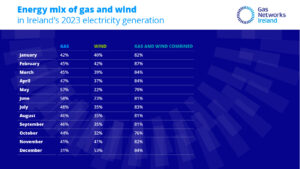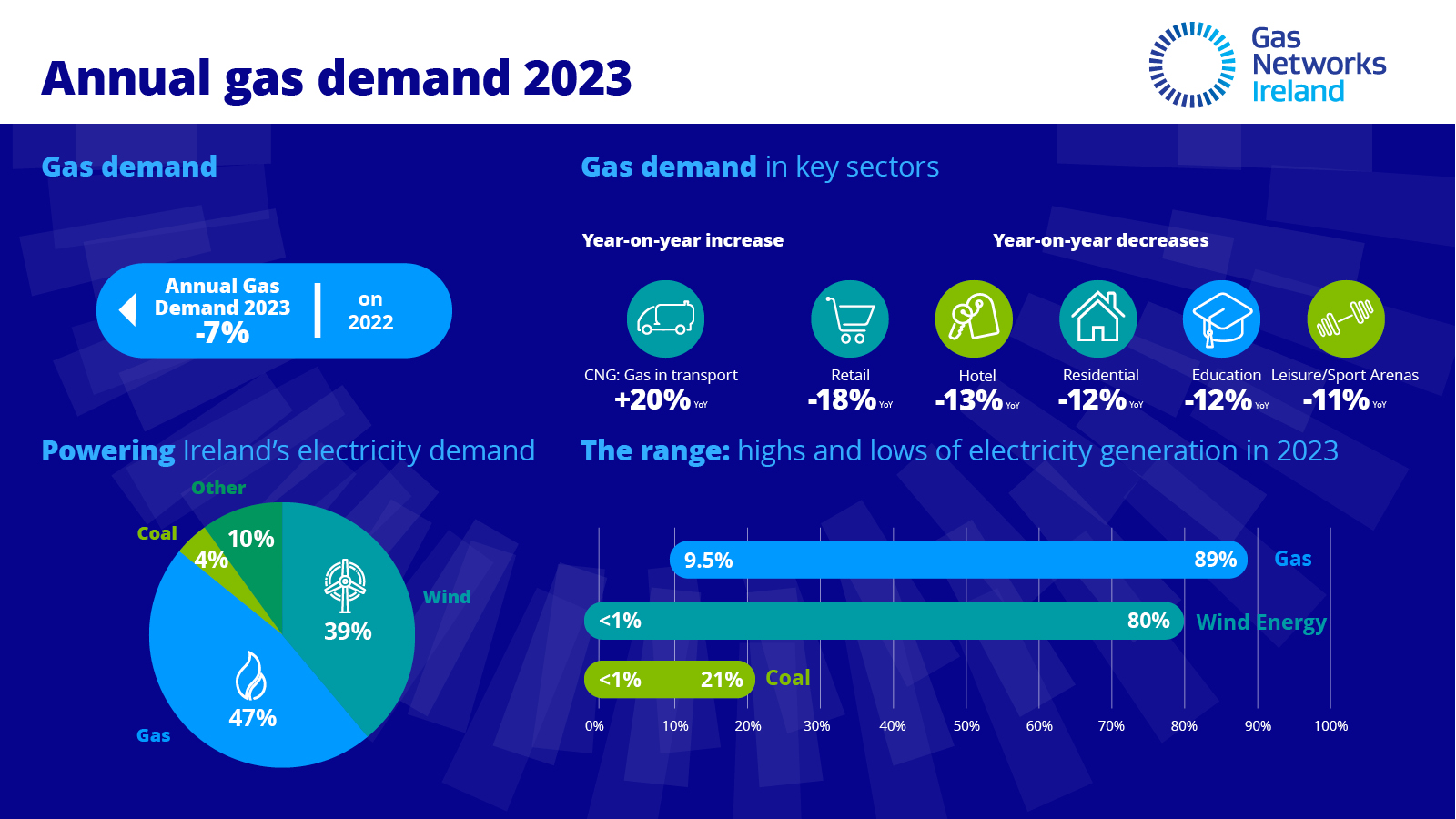- Gas generated 47% of total electricity last year
- Demand for compressed natural gas (CNG) in transport increased by 20%
- Work continues on repurposing gas network for renewable energy
Wednesday Jan 24, 2024: The 2023 Gas Networks Ireland annual demand statement shows that overall demand for gas in Ireland decreased by 7% year-on-year when compared to 2022, due to an increase in energy powered by wind.
Gas generated 47% of total electricity in 2023 versus 48% in 2022. While wind’s overall contribution to electricity generation increased from 34% in 2022 to 39% in 2023.
Electricity Generation
Gas was the largest energy source of electricity generation in Ireland for the first 10 months of 2023, and wind energy was the key source in December. Both wind and gas made an equal contribution of 41% in November.
Gas generated 47% of the total electricity used in Ireland in 2023, with wind energy contributing 39% and coal providing 4%. June saw the highest reliance on gas during the year, as it provided 58% of electricity supplies during the month. Wind energy made its largest contribution in December, generating 53% of all electricity in the State.
Gas peaked at 89% of electricity generation during April, but never fell lower than December’s 9.5%. Wind peaked at 80% in December, but at times fell to lower than 1% every month.
Commenting on the annual gas demand figures for 2023, Gas Networks Ireland’s Acting Director of Strategy and Regulation, Brian Mullins, said:
“In 2023, Ireland’s national gas network continued to play a central role in meeting the country’s energy needs. During periods of low or absent wind, it ensured a continuous flow of electricity – essentially keeping Ireland’s lights on when the wind didn’t blow.
“Throughout January to December, there were days each month where wind energy – reliant on weather conditions – could only generate minimum electricity due to calm weather. On those days, gas provided the necessary backbone supplies and overall, in 2023 gas generated the majority (47%) of Ireland’s electricity. Overall, when combined, gas and wind energy generated 86% of Ireland’s electricity demand.”
Demand for gas in transport saw significant increases in 2023
In 2023, demand for compressed natural gas (CNG) in transport saw a significant year-on-year increase, up 20% compared to 2022. Fuelling with CNG can reduce a heavy good vehicle’s emissions by up to 22%, and with CNG suppliers now sourcing gas via renewable sources, BioCNG can provide the Irish haulage industry with a clean alternative fuel option.
In May, Gas Networks Ireland announced that carbon neutral BioCNG is available for heavy goods vehicles at Circle K’s forecourts in Limerick on the Ballysimon Road; in Tipperary, just off the M7 in Cashel, as well as the Dublin Port and Clonshaugh forecourts in Dublin.
In November, Gas Networks Ireland and Virginia International Logistics took another step forward in reducing emissions from Ireland’s transport industry with the opening of Ireland’s eighth CNG refuelling station.
Mr Mullins continued:
“The increasing demand for renewable gas from the transport sector is a positive trend. Despite representing just 3% of vehicles on the road, Ireland’s commercial transport fleet contributes approximately a fifth of the sector’s carbon emissions, making it a challenging area to decarbonise.
While electricity is a proven alternate fuel for cars, electric solutions are not an option for use in Heavy Goods Vehicles, however CNG and its renewable equivalent, BioCNG, can substantially reduce emissions in the HGV sector.”
A look back at overall gas demand in 2023
A mild start to 2023 meant that gas demand fell month-on-month in both January (-8%) and February (-11%). However, in an unusually wet and dull March, gas demand increased 14% on February.
In April, demand for gas fell 14% month-on-month. May was a calm month with little wind, which meant that gas provided a much needed back up to compensate for the fall off in wind energy (-38% month-on-month), generating a total of 57% of Ireland’s electricity in May.
During the summer of 2023 when the country experienced very changeable weather, gas provided 87% of electricity generation at its peak during the month of June, while in one of Ireland’s wettest Julys on record, gas demand decreased by 18% year-on-year. In a mild and changeable August, gas demand fell by 21% year-on-year while wind energy’s contribution to electricity generation jumped from 19% in August 2022, to 35% in 2023.
September was a very mild, sunny, and wet month that brought everything from heatwaves to the first named storm of the season. With less wind available during the heatwave at the start of the month*, gas stepped up and generated two thirds of the electricity needed in the country. In contrast, during the stormy and windy end to September, wind energy generated 35% of the country’s electricity. However, at the same time, gas’s contribution peaked at 88% and never fell below 11% at any point in September.
A mild yet very wet October saw Ireland’s gas demand increase by 13% on the previous month, with a 3.5% rise on the same month last year. While in November, the last three days of the month saw exceptional levels of gas demand, with the 30th and the 28th respectively being the highest two November gas demand days ever recorded, with gas playing a critical role in electricity supplies in Ireland.
2023 closed out with a mild but stormy month. Storms Elin, Fergus, Gerrit and Geraldine meant that there was plenty of wind, and thus plenty of wind energy available to generate 53% of the electricity needed in Ireland in December – an increase of twenty percentage points on December 2022. Gas’s contribution to electricity generation never dropped below 9% and reached up to 84% at times.
Working on the transition to renewable gases
Throughout 2023, Gas Networks Ireland continued working to increasingly replace natural gas with renewable gases; both the renewable gas of today – biomethane made from farm and food waste, which is already being produced and used in Ireland; and the renewable gas of the future – green hydrogen produced from offshore wind.
In July, the Government published the National Hydrogen Strategy which recognises the crucial role the gas network will play in specific areas of Ireland’s energy system – particularly the hard-to-abate sectors such as transport, industrial heating and power generation.
In September Gas Networks Ireland launched its Biomethane Energy Report at the Irish Renewable Gas Conference. The report identifies 176 projects throughout Ireland that have the overall potential to produce up to 14.8 terawatt-hours (TWh) of biomethane per annum, amounting to 26% of Ireland’s current gas demand, which could reduce carbon emissions by almost 4M tonnes a year.
Mr Mullins added:
“Ireland has a real opportunity to develop a biomethane industry at scale, and we are working closely with all stakeholders in that area – including the Government – to kickstart this. The imminent National Biomethane Strategy will complement the National Hydrogen Strategy, and Gas Networks Ireland will facilitate the transmission of these renewable gases through one of Europe’s most modern networks.
We are excited by the future and will continue to work hard to deliver for Ireland’s energy needs, along with continuing to decarbonise the gas network.”

